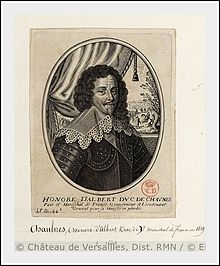Honoré d'Albert
Honoré d'Albert (* 1581 ; † 1649 ), Seigneur de Cadenet, Seigneur de Picquigny and Vidame d'Amiens . Through his marriage to Claire Charlotte Eugénie d'Ailly in 1620, he acquired the name, the coat of arms and also the reputation of the House of Ailly . Since 1619 Maréchal de France , since 1621 Duc de Chaulnes and Peer of France , he was a French aristocrat and military at the beginning of the 17th century. He served in the army of Louis XIII.
Life
At the king's court he was called Seigneur de Cadenet . His brother was Charles d'Albert, duc de Luynes , favorite of Louis XIII. The king made Honoré d'Albert or Cadenet Lieutenant du Roi in the governorate of Amboise in 1615 . In 1617 he became Mestre de camp in the Régiment de Normandie after the previous commander, the Comte de la Penne, son of the Maréchal d'Ancre, had been exiled.
In 1619 he became Lieutenant General in the Picardy Governorate and was awarded the Order of a Chevalier des ordres du roi .
In 1621 he was appointed Duc de Chaulnes and Pair de France and took the name Maréchal duc de Chaulnes. In the same year he served in the siege of Saint-Jean-d'Angély and the siege of Montauban . After the death of the Connétable de Luynes, Charles d'Albert, duc de Luynes , he was transferred to the administration of the city and citadel of Amiens . Together with Jacques Nompar de Caumont , Duc de la Force, he commanded the army in Picardy in 1625 and was able to secure this Burgundian province for the king. In 1635 he was appointed governor here. With the same army, he fell in 1635 in the then to the Spanish Netherlands belonging Artois one, conquered and destroyed several castles and captured the village Grévillers at Bapaume . When he withdrew, he burned everything down so as not to leave any supplies to the enemy. After a 14,000-strong Spanish army was mobilized to put a stop to the Maréchal de Chaulnes, the latter then distributed his troops to the cities near the border, thus posing a further threat to the Spaniards. After receiving 1,500 riders equipped with Boulonnais as reinforcements , he moved again against the Spaniards, who then retreated. When new cavalry regiments were set up in 1636, he became the owner of one of these regiments. After the flags had caused extensive reprisals and devastation during the campaign in Picardy, the Maréchal de Chaulnes reacted by drawing together 1,200 men from his garrisons in January 1636 and making an incursion into the Artois. Here he burned several castles and villages and destroyed a troop of 400 Irish who had fought in Spanish service.
In 1640 he commanded together with Gaspard III. de Coligny , Maréchal de Châtillon, the siege of Arras , which was taken on August 10th. After that, the Maréchal de Chaulnes did not take part in any more campaigns. In 1645 he moved from the governorate of Picardy to that of Auvergne . He held this post until his death in 1649.
Because of his preferred hairstyle, which consisted of two braids behind the ears and a ponytail, which was flanked by two more braids , this was called "Mode la cadenette".
Marriage and offspring
On January 14, 1620 he married Claire Charlotte Eugénie d'Ailly, Comtesse de Chaulnes , they had three children:
- Henri Louis d'Albert d'Ailly (1620-1653), 2nd Duc de Chaulnes;
- Charles d'Albert d'Ailly (1625-1698), 3rd Duc de Chaulnes;
- Armand d'Albert d'Ailly (1635-1656).
literature
- Chaulnes (Honoré d'Albert, Duc de). In: Marie-Nicolas Bouillet , Alexis Chassang (eds.): Dictionnaire universel d'histoire et de geographie . Nouvelle édition (Vingt-Sixième). Hachette et Cie, Paris 1878, p. 401 .
- de la Combe: Chaulnes (Honoré d'Albert, Duc de). In: Louis Gabriel Michaud (ed.): Biographie universelle ancienne et moderne, ou histoire, par ordre alphabétique, de la vie publique et privée de tous les hommes qui se sont fait remarquer par leurs écrits, leurs talents, leurs vertus ou leurs crimes . Volume 8. Nouvelle édition. Desplaces, Paris 1854, p. 37 .
Footnotes
- ↑ Representative of the king in a region or a permanent place. He was subordinate to the governor. Was abolished in 1791, but later re-established several times. No military rank
| personal data | |
|---|---|
| SURNAME | Albert, Honoré d ' |
| BRIEF DESCRIPTION | French Marshal |
| DATE OF BIRTH | 1581 |
| DATE OF DEATH | 1649 |

